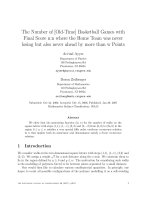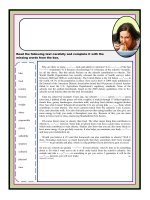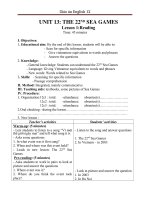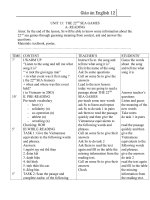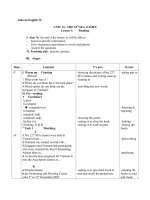Bridges breakout the number rack games
Bạn đang xem bản rút gọn của tài liệu. Xem và tải ngay bản đầy đủ của tài liệu tại đây (110.95 KB, 5 trang )
The Number Rack
Games
Bidding Sliders
Whoever slides the last bead in the top row to the right side wins. To move beads,
though, players bid—using beads in the bottom row—and whoever bids more on
each turn earns the right to slide 1, 2, or 3 beads in the playing row from the left side
to the right side. Watch a sample game!
Get Ready to Play
• Players share a student number rack for this game.
• Move all beads in the top row to the left.
• Divide the beads in the bottom row so that each player has 5. Slide all the red beads to
the left for one player and all the white beads to the right for the other player.
Initial Game Setup
On Your Turn
1 Bid for the right to make a move. You can move only if you bid more than the other
player.
To start the game, Player A has the tiebreaker advantage, so if both players bid the
same number of beads, Player A can decide to invoke the advantage and take that
move; or, they can decide to not invoke the advantage (keeping it for future use), and
Player B would take that move. If the advantage is invoked, the player who invoked it
makes the move, but then the advantage transfers to the other player for future use.
Note: A player can bid 0 on their turn, if they want to forfeit the right to move and just
collect the other player’s bid.
2 If you outbid your opponent, slide the number of beads that you bid from your side to
your opponent’s side in the bottom row.
Bridges Breakout: The Number Rack
|
Games
© The Math Learning Center
2
3 Also, make your move by sliding 1, 2, or 3 beads in the top row to the other side of
the rack.
For example, if Player A bids 2 and Player B bids 3, then Player B gives 3 beads to
Player A in the bottom row and then makes a move of 1, 2, or 3 beads in the top row.
I outbid you with 3 beads, and then I
moved 1 bead in the top row.
4 If you have no beads remaining in the bottom row, you must bid 0 beads on that turn.
Note: It’s possible for both players to bid 0, and a player could use the tiebreaker
advantage to take the move.
Ending the Game
When all beads in the top row have been moved to the right, the game ends. The player
who moved the last bead wins!
Bridges Breakout: The Number Rack
|
Games
© The Math Learning Center
3
Nim
Players take turns sliding 1 or 2 beads to the other side, and the player who slides
the last bead to the other side wins.
Get Ready to Play
• Share a student number rack for this game.
• Move all beads in the top row to the left. (Move the beads in the bottom row to the right to
show that they will not be used.)
On Your Turn
1 Slide 1 or 2 beads in the top row from the left to the right.
2 Say how many beads you moved, and how many remain.
I moved 2 beads to the right, and 3
beads remain on the left.
Ending the Game
When all beads have been moved to the right, the game ends. The player who moved the
last bead wins!
Variations
• The player who moves the last bead to the right loses instead of wins. How does this
change your strategy?
• Players may move a different number of beads on each turn. For instance, instead of
just 1 or 2 beads, players can move 1, 2, or 3 beads on each turn; or, maybe players are
limited to moving either 1 or 3 beads on each turn but not 2.
• Use both rows of beads. Players can move any number of beads on a turn, but beads can
be moved from only one row in a given turn. (That is, a player cannot move some beads
from the top row and some beads from the bottom row on the same turn.) The player to
move the last bead wins.
Bridges Breakout: The Number Rack
|
Games
© The Math Learning Center
4
Oddly
One player plays for an even number, and the other player plays for an odd number.
They take turns sliding 1, 2, or 3 beads from the middle to their side of the rack. The
even player wins if both sides end with an even number of beads; the odd player
wins if both sides end with an odd number of beads.
Get Ready to Play
• Share a student number rack for this game. Move all beads in the top row to the middle of
the rack. (The beads in the bottom row will not be used.)
• Decide if you will be the odd or even player.
• Decide if you will slide beads to the right or left side of the rack.
On Your Turn
1 Slide 1, 2, or 3 beads in the top row from the middle to your side of the rack.
2 Say how many beads you moved, and how many are now on your side of the rack.
I moved 3 beads to my side, and I know
have 5 beads on my side of the rack.
Ending the Game
When all beads have been moved from the middle, the game ends. The odd player wins if
there are an odd number of beads on each side; the even player wins if there are an even
number of beads on each side!
Variation
Use both rows of beads. Players can move 1, 2, or 3 beads from either row on a turn, but
beads can be moved from only one row in a given turn. (That is, a player cannot move some
beads from the top row and some beads from the bottom row on the same turn.)
The odd player wins if there are an odd number of beads in all four piles at the end of the
game; the even player wins if there are an even number of beads in all four piles. It’s a draw
if there are two piles odd and two piles even.
Bridges Breakout: The Number Rack
|
Games
© The Math Learning Center
5



